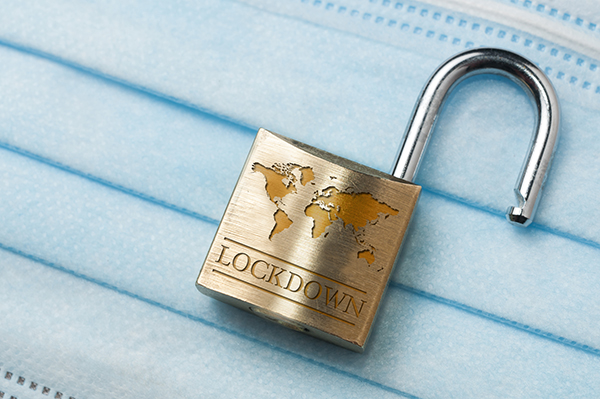
Of course, the Wuhan coronavirus (COVID-19) pandemic is the root cause. But the collective reaction of governments around the world has more to do with it than the disease itself.
Many countries responded to the pandemic by imposing lockdowns or movement restrictions. As a result, retailers and manufacturers fail to pick up their cargoes and containers because their warehouses are either full or closed.
Some ports remain open but with reduced workforce, exacerbating the cargo congestion. This has now caused a disruption in the supply chain, particularly the movement of essential goods and foodstuffs. Uncollected cargoes at ports create congestion and take up space, reducing their capacity to accommodate incoming cargoes and containers.
Consumer demands have changed dramatically throughout the pandemic. Essential commodities have seen a staggering increase in demand, especially disinfectant products, medical supplies, groceries and paper goods has . (Related: Covid supply chain woes worsen as prices soar, shelves run bare.)
Air cargo has also seen an overall increase in use during the pandemic, with essential goods being transported across the world. Some passenger planes have even been retrofitted to carry more cargo inside the cabin.
But manufacturers – largely due to labor shortages – have had difficulty trying to keep up with the demand, slowing down the entire freight industry. While planes are ready to fly and truck drivers are ready to haul freight across the country, the goods, unfortunately, are not there to make the journey.
Food prices continue to rise as world runs short of workers
Bloomberg published an article last month that predicted global food prices will continue to go up as the "world runs short of workers."
In Vietnam, the army is assisting with the rice harvest; in the U.K., farmers are dumping milk because there are no truckers to collect it. In Brazil, robusta coffee beans took 120 days to reap this year, rather than the usual 90. In the U.S., meatpackers are trying to lure new employees with incentives while fast-food chains are raising the prices of burgers and burritos.
Labor shortages have flustered the global food ecosystem. Some employers are now forced to raise wages despite financial difficulties. Workers are also demanding greater protection from COVID-19. Meanwhile, restaurant workers in cities with vaccine mandates like New York are opting to resign rather than get experimental COVID-19 vaccines or are serving as vaccine police at work.
Lockdowns drive ship crews away
Lockdowns have contributed to the labor shortage in the shipping industry. (Related: 'System collapse': Supply chain workers warn of impending breakdown because COVID shutdowns have drained the workforce and worsened product shortages.)
The Philippines, China, India and Indonesia are among the biggest suppliers of crew members. But lockdowns and other pandemic restrictions have caused thousands of crew members to be stranded worldwide.
Airline and port restrictions in most of these countries have made it nearly impossible for crew members to get home if the governments do not make special arrangements. Even if a ship reaches an open port, the crew members may still be out of luck because most international air traffic is grounded.
Many of those crew members have decided to look for other jobs, creating a massive hole in the shipping industry workforce.
Supply chains already strained before pandemic
The pandemic has exposed the fragility of the global supply chains. But some say supply chains are already headed south regardless of the pandemic and the resulting restrictions.
Looking back at 2019, spot rates were basically flat-lining as the freight market was experiencing a cycle of oversupply and stagnant demand. Many feared a recession was imminent.
A sluggish industrial sector in which industrial production growth was negative for nearly a year indicated stagnant business and infrastructure investment – a sign that the economy was entering a phase of risk aversion and consolidation.
The U.S. government was able to quickly pass a stimulus package that spurred consumer demand to new heights. Consumers took the reins of the economic recovery by using the stimulus money and savings from not driving to work, buying new clothes and dining out to remodel their houses and purchase electronics.
The onslaught of unexpected demand caught most shippers and transportation providers off guard as they were expecting the next depression. They quickly found their once overstocked inventories depleted and needed to order more goods – all at once.
Shippers began to order not just for replenishment but for the future to avoid missing revenue.
Most durable goods like electronics and furniture come from Asia, while most consumers of these products live in the eastern half of the United States. It takes several weeks from the initial order date to get goods from China to New York City. To prevent inventory shortfalls, shippers need to order months in advance.
Shippers learned to increase their order sizes as production became strained; but by then, transportation providers were reducing capacity. This meant that demand quickly outstripped supply on multiple levels. These were happening prior to the pandemic.
But without question, the pandemic and resulting lockdowns and other restrictions have magnified the strain in the global supply chain.
Follow Pandemic.news for more news related to lockdowns and other measures implemented by governments during the coronavirus pandemic.
Sources include:
Please contact us for more information.




















